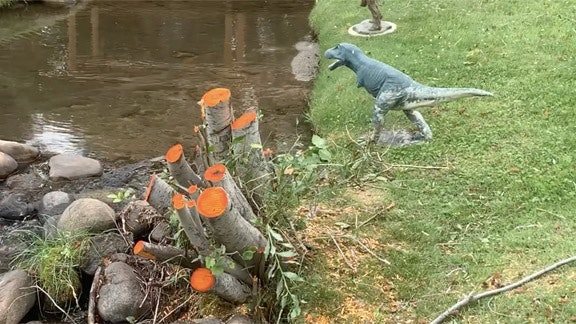Heck, who ever heard of an Alder tree?
I have heard of aldermen who are usually dishonest city councilors in Chicago. We have an altar at our local Catholic Church. For some reason I have heard of alderberries, but not sure where. The empire of Alderaan was featured in Star War movies. Oh well.
We live along Big Dickinson Creek in Lander and have an abundance of what I thought were River Willow trees along its banks. They are junk trees.
My grandson Hayden Johnson calls them giant weeds. But my wife Nancy will never let me cut down a tree. We even have groves of Russian Olive trees, which are considered a noxious weed in Wyoming. Yes, that is true.
But lately my River Willows are dying. Thank God. It is about time. Some kind of tiny ugly black worms are swarming all over them and apparently causing them to wither and die.
So, what to do?
Retired Professor Jack States, who know everything about trees, was brought in to consult. I took some photos and emailed them to him with my question: “What to do?”
First, these are not River Willows, he said to my surprise. They are “Alder” trees. In fact, his exact comment was:
“I think I have an ID on the black worms– the larval state of the alder flea beetle. I’ve copied for you an internet photo and description of them here. As you will note, they do not generally feed on willows but specialize on river alder, Alnus incana, that grows along the Popo Agie River and its various tributaries. The leaves of nearly all of the Alders on my property have be skeletonized this summer by these devils. Your photo has one of these beetles on what looks like alder bark to me.”
So, the aforementioned grandson Hayden, who is quite handy with a chainsaw, came in and removed seven of these Alder clusters. Often one root had a dozen trees growing up and out of it.
An amazing result of that is that the stump turned a bright orange, almost as if it had been sprayed with some kind of hunter safety orange glow paint.
Anyway, if this column has not put you to sleep yet, here is some other information that Jack sent me concerning this situation:
Alder flea beetle, Macrohaltica ambiens (Altica ambiens), is a chrysomelid beetle which can eat the leaves of its host trees.
Both adults and larvae feed on the foliage. There is one generation a year. The adult beetles overwinter in the duff at the base of the plants.
They emerge in the late spring/summer (mid-June in 2007 and as early as the beginning of May in 2013), mate, and lay their eggs on the undersides of the leaves.
The larvae appear shortly after, reaching maturity in August. The larvae then drop and pupate in pupal chambers in the soil below the leaf litter. The pupal stage lasts about 10 days. The adults emerge and feed on the leaves in August.
Alder is listed as the main host of this insect. Although management in landscapes is probably not required, nursery growers might approach alder flea beetle management similar to management of other skeletonizing flea beetles such as elm leaf beetle.





